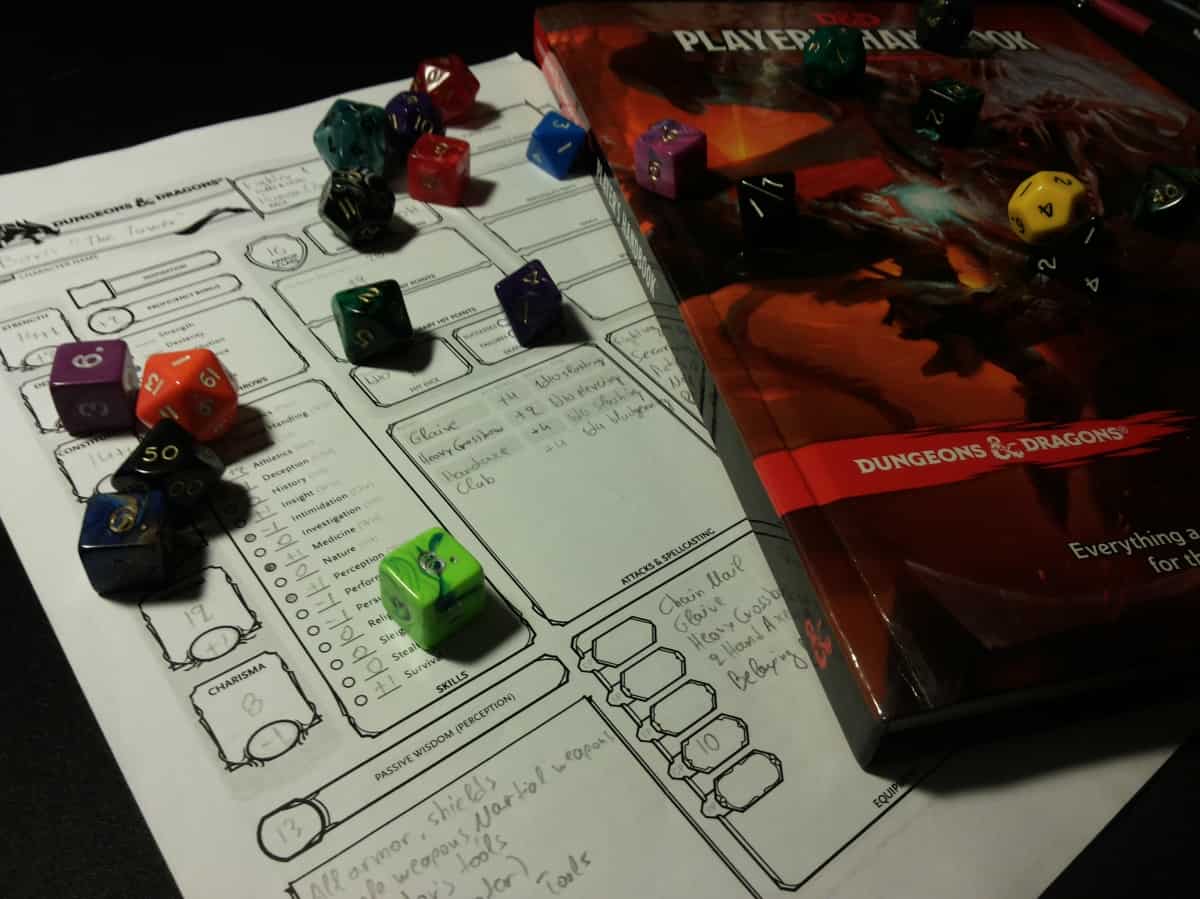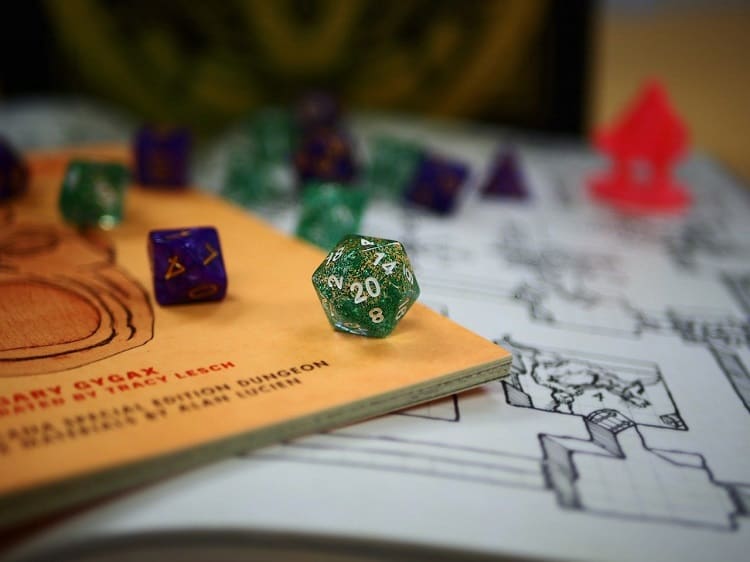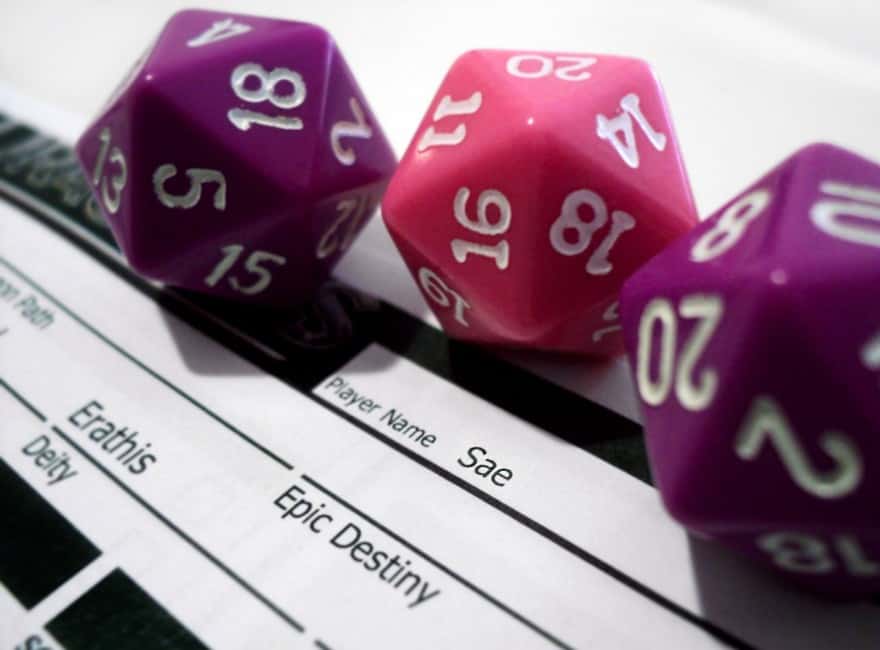So you have decided to start a new – or maybe even your very first – Dungeons & Dragons adventure. If you have picked the 5th edition, our Starting Array 5e Options Guide is perfect to put you on the right track.
Luckily, DnD 5e isn’t all too different from the previous editions. One of the very first things you will have to do is create a character. You can choose a race, a class, features and if you are going all the way you can think of an elaborate backstory.
You also need to pick the stats for your new player character. The Starting Array is one of the aspects most beginning and veteran players alike seem to overthink or try to optimize as much as possible. Officially, this is an optional process on how to get the ability points or scores for your new character.
There are a couple of ways to get a starting array. We will discuss the three most important ones here.
The most often used method is that you roll the dice to have your stats determined by luck. There is also the point buy method that is pretty popular for 5e players. Finally, oftentimes when a DM wants a more balanced game, he will ask you to pick a standard array.
If you aren’t familiar with what any of this is, you are in luck. In this starting array guide for 5e, I will go quite in-depth on what these methods are and how to use them.
Standard Array in 5e DND
What is a Standard array?

As you might have guessed, the standard array is a prefixed array of points for abilities. There are no variables in the numbers you can assign for e.g. intelligence, strength, etc. when making a character. This takes away the element of randomness. You do have some ability to choose where the numbers go. You get 6 predetermined numbers – no matter your race or class – which you have to put into your character sheet.
These are the numbers: 8, 10, 12, 13, 14, 15
You can put these numbers anywhere you want, but you have to use all 6. These numbers don’t take into account your racial bonus. So as an example, you are playing as a wizard. A good pick would be to put your 15 into intelligence and the 8 into strength. However, you can do whatever you like. If you want to go nuts and put 15 into charisma and 8 into intelligence, no one is stopping you. These numbers are fixed, so in theory, you can not pick a number lower than 8 if that would fit your character better. Of course, your DM has the final say about this.
Once you have picked which numbers correspond with Dexterity, Constitution, Intelligence, Strength, Wisdom, and Charisma, it is time to apply the racial bonus you get from the race of your character. When you are playing as a human, everything goes +1. That is the human racial bonus. So your stats after the racial bonus modification are 9, 11, 13, 14, 15, and 16.
The pros
The first pro is the sheer simplicity. The standard array is very much recommended if you are new to Dungeons and Dragons. If you are a DM and you have a new player in the group, using a standard array to have players make their character saves a lot of time. You don’t have to explain how to roll dice, how you calculate your stats, and you don’t have to bother with removing the lowest one. That means you can spend a lot more time explaining other aspects of the game.
The second pro is that the standard array provides a pretty decent balance for a player character and party as a whole. This makes the start of a campaign a lot more fun. You don’t have to take into account someone with horrible luck that is dragging your party down, and you don’t have that one guy who can almost one shot everything with ease. This is a reason why a lot of veteran players decide to use a standard array and just take the randomness out of the ability distribution.

The balance also saves a lot of stress and math. You don’t have to start over-optimizing or trying to work out your bad points. You can fully concentrate on enjoying the story. The standard array gives you a very straightforward distribution. You will in 99% of the cases use the 15 for your most important stat and 8 for the one you don’t really need. You don’t have to start figuring out anything.
Third, it is a great way to teach new players the importance of ability distribution and racial bonuses. Your players can straight away attribute the 15 to their most important stat and don’t run the risk of having a horrible roll. If you are a DM and want to make the starting game a little more easy for absolute beginners, you can always change the standard array and use numbers that are a little higher.
The cons
For new players, it can still be a bit overwhelming. Dice rolling and point buying are done one by one. Using the standard array means you have a lot of numbers in front of you all at once. You will have to explain stat priority, the downsides of putting a 15 in for example strength as opposed to intelligence, and so on.
Giving all those numbers at once risks the possibility of the player not really understanding why and how these stats influence the (beginning) of the campaign so much. The reason for this is that he gets overloaded with information straight from the beginning. Dice rolling on the other hand really gives you the chance to explain the stats roll by roll.
Second, sometimes a balance and less randomness can be a bit less fun and not so emerging. In real life we aren’t born equal with some stats to attribute to skills, a lot of it is left to random chance. The fact that all players are very equal in strength, with the only real ability modifier being the racial bonus, can make for a bit of a boring and predictable start to the campaign. If you dice roll, there is a chance you end up with a pretty dumb wizard with massive strength stats. Which could be a lot of fun and offer a completely different playing experience.
Choosing the standard array makes everything, well, pretty standard. There are no extreme characters that force you to either think tactically and use your party to compensate for weaknesses. In my opinion, using the standard array is great for new players and veterans who want to focus on the story and not so much on the challenge.
How you should (not) use standard array
How you should attribute your stats isn’t exactly rocket science. Every single class or build you want to create is going to be a little different, but the general idea is the same.
The big 15 is going to go in your most important ability. If you are going to play as a barbarian, then this will be put in strength. If you want to be an awesome wizard, you will have to put this number into intelligence.
As a small tip, the constitution should never be your best state. While it is pretty useful to have enough hitpoints that you don’t die, you still want to be able to pack a punch.
8 is a pretty low number, and the drop-off in ability between 10 and 8 is a lot bigger than you might think. You will have to put this number in an ability that you will likely never have to use, and that a party member of yours can compensate for. In general, if you are not playing a wizard, intelligence is a pretty good pick to put the 8 in. At most, you will miss a couple of skill checks, and almost every single party will have a wizard that can do the important rolls that require a good intelligence ability.
The other 4 stats are less important, where you spread them around and give you the freedom to experiment with your character a bit. If you don’t have a secondary stat that is very important for your character and the way he fights, I recommend you put the 14 into constitution, which will help you survive strong monsters and encounters during the game.

Dice rolling to get your starting array
The most common way to determine your starting array is using the dice. While it is the most common method, it is also the most chaotic one. It adds tonnes of randomness to the start of your campaign. This can be great or horrible depending on what your playing style is and how much (bad) luck you have. There are some different versions on how to approach dice rolling for stats, depending on how much craziness you want. Generally, there are two different ways to determine which ability gets what number.
The first one is the one used the most. You get three d6s dice – or any other, but these are most common for this – and roll them a couple of times. Let’s say you get 18, 14, 13, 13, 10, and 7. Now you can start attributing these numbers to the ability you want. So you can pick the 18 to go into the stat you want to be the highest, and the 7 in the skill you don’t really mind about.
The second one is a lot more random but can be very fun. Here you pick your ability first, and then you roll. The number you roll is the ability score it gets. So if you are a wizard, and you roll a 9 for your intelligence, well that is some pretty bad luck for you!
In D&D 5th edition, there is a suggestion to somewhat counter this bad luck. Instead of rolling three dice, you roll four and ignore the number on the lowest die. You add the 3 highest and voilà, you have your ability score. This is just a suggestion and by no means a rule. There are many approaches to dice rolling for stats, and a lot of the time it simply depends on what your DM wants to do.
There are some other methods that I think are pretty good if you want to make sure you end up with a very underpowered character from the start.
- Roll two d6, and add 4 to the number you get. This way you almost always get a non-horrible stat.
- Roll 20d6 dice, skip the lowest two rolls, and then you arrange your roles in groups of 3 to your liking.
- Roll the 3d6 10 times and drop the 4 lowest.
Point buy
Just like the standard array, the point buy method does not require you to use dice. Your DM will give the players points, and they get to choose how they will distribute them amongst their abilities.
In the 5th edition of Dungeons and Dragons, you get 27 points you can use to buy better abilities. The basic rules of the 5th edition give this table to determine how much an extra ability score point costs.
| Score | Cost | Score | Cost | Score | Cost |
|---|---|---|---|---|---|
| 8 | 0 | 11 | 3 | 14 | 7 |
| 9 | 1 | 12 | 4 | 15 | 9 |
| 10 | 2 | 13 | 5 | N/A | N/A |
Getting an ability with a score of 8 will cost you 0 points. However, if you want one of your six abilities to be 14 for example, this will cost you 7 points. Meaning, you only have 20 points left to buy abilities for your other stats.
I like the point buy method because it makes sure you don’t get these crazy situations you might guess when leaving it to the dice. At the same time, it also requires a bit more brainpower than just assigning stats as is the case with the standard array.
The point buy method is also pretty flexible. Your DM can assign more points to newer players who might need a bit of help, or less to veteran players who need a challenge.
What to remember about Starting Array’s
While your starting array will have an impact on the game, you shouldn’t be too worried if you have bad luck rolling the dice or wasted some points when using the point buy method. The game is long and there are plenty of opportunities to make up for mistakes by leveling up. If your party is large, your weaker stats will often not matter at all.
If you are a DM and a new player messed up, don’t have them start over, but use this as a learning experience. You can always help him or her out by making sure they find just the right stat boosting items in a dungeon or an abandoned mansion. If the opposite happens, and a player is obviously overpowered, don’t be afraid to throw a stat reducing curse his way. That way, the starting array has little (negative) impact mid and late game.
Frequently asked questions
Question: What is the best starting array method for beginners?
Answer: This really depends on the kind of player you are. If you like randomness and want to have an unpredictable adventure straight from the start, you will love dice rolling. Personally, I like the point buying method the most for beginners. It gives you a chance to explain the importance of picking the right stats for certain abilities, and there is a lot more customization while keeping all characters balanced.
Question: Does the starting array have a big impact on the campaign?
Answer: Most of the time it doesn’t. Of course, the dice method can go pretty wrong or your experiment with a 15 strength wizard goes completely south. However, generally speaking, a couple of bad rolls and some bad luck isn’t game-breaking if you are playing in a larger party of 4 to 5 players.
Question: What is the most common mistake new players make?
Answer: The mistakes I see most often are made with the point buying method. A lot of people waste points on getting every skill to at least a 10. Having a skill at the lowest number (8) isn’t a big drawback at all. At most, you will miss some trivial skill checks. It is much better to have your best skill at 15 instead of 14 than have a 10 instead of an 8.
- Monks 5e Guide: How to Play as a Monk in D&D - September 13, 2021
- DnD Hobgoblin Guide [Creatures and Playable Race] - September 9, 2021
- The Ultimate DnD Yklwa 5e Guide: Everything You Need to Know - September 5, 2021

